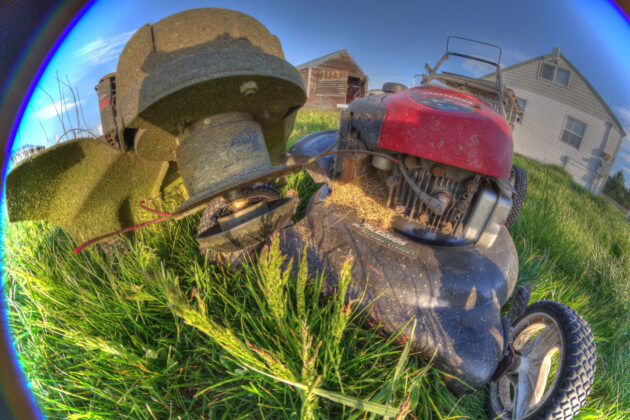
I live in a corner of New Jersey that was the epicenter for exurban, sprawling development that defined much of the late 1990’s up through the financial crash of 2008. The 5-acre lot subdivisions that dot the otherwise agrarian landscape of my community are great for bicycling detours with their expansive, paved streets and practically zero car traffic.
As I pedal through these neighborhoods of houses that all look the same surrounded by their moats of lush green, I marvel at the armada of riding lawn mowers called to service on any given Saturday during peak mowing season, and the fortitude it must take to give up one’s weekend to ensure compliance with the local homeowners’ association rules.
My suspicion of lawns as resource hogging wastes of time and space is confirmed by the EPA — one gas mower running for an hour emits the same amount of pollutants as eight new cars driving 55 mph for the same amount of time. That’s one hefty climate change impact, not to mention the money wasted trying to keep up with the Joneses.
But with market trends shifting in New Jersey, and baby boomers and millennials eschewing large suburban homes for more densely populated, transit friendly, walkable towns and cities, what is to become of these places? Who will live here over the next few decades, and will they continue to care about their expansive, expensive green lawns?
Erik Assadourian, senior fellow at the World Watch Institute, a leading nonprofit working to accelerate the transition to a sustainable world, has developed an intriguing project to reimagine the suburban model and address the significant barriers to long-term sustainability, like water-sucking, climate-change-impacting lawns, while meeting the multi-generational needs of families and communities.
Assadourian is a big thinker and has spent his career at the Institute pondering ways to influence cultural shifts. He noted the higher unemployment rate for young Americans and the reality that 36 percent of those between the ages of 18-31 live with their parents. He thought of the places many of those young men and women were moving back to, and what potential these places had to provide an economically and environmentally sustainable lifestyle for the modern multi-generational family.
His brilliant idea? Yardfarmers.
Yardfarmers is a new documentary/reality TV series that asks: What happens when you take six young Americans and move them back in with their parents to farm their parents’ yards or neighborhood greenspace? The college grads will compete for a large cash prize and the title of America’s Best Yardfarmer. Imagine the fun of convincing one’s parents that this isn’t just another one of your hair-brained schemes, or battling the local homeowner’s association over your chicken coop.
While the show doesn’t air until Spring 2017, “yardfarmers” as a concept could help solve many of our current challenges — from growing food insecurity and the abuses of industrial agriculture to social isolation and climate change. It’s one step in the right direction in solving the challenge of converting those large suburban lawns I pass on my bike into productive spaces that can support families and provide entrepreneurial opportunities for young people.
Assadourian’s theory is interesting to ponder as we try to imagine what our suburban and exurban communities will be like and who will live there in the future. Will we find a new use for hulking lawn mowers, converting them into solar-powered tractors to plow our new yardfarms?
We need more creative solutions like this one to create sustainable, healthy communities. Time is a precious commodity, we might find more fulfillment refocusing the hours we would have spent mowing on harvesting yard vegetables and cooking, spending time with family, or getting engaged in our communities. Maybe the idea of yardfarmers will inspire you to clear part of your lawn for a raised garden bed.
I am looking forward to following Yardfarmers the series. Assadourian’s already recruited six young Americans from diverse communities for the first season of the show, and he’s got a filmmaker and producer.
Now he just needs a distributor. Note to National Geographic/Discovery Channel/PBS, this is a reality show I would watch.

Margaret Waldock is the Environment Program Director at the Geraldine R. Dodge Foundation. Prior to joining Dodge in 2011, Margaret was Executive Director of the Hunterdon Land Trust for eight years, where she oversaw an expansion in net assets, staff, members and donors and helped preserve over 5,000 acres of land.
Dodge’s environment grants encourage comprehensive thinking about how to safeguard our water and reinforce our natural systems in order to promote more sustainable communities.
